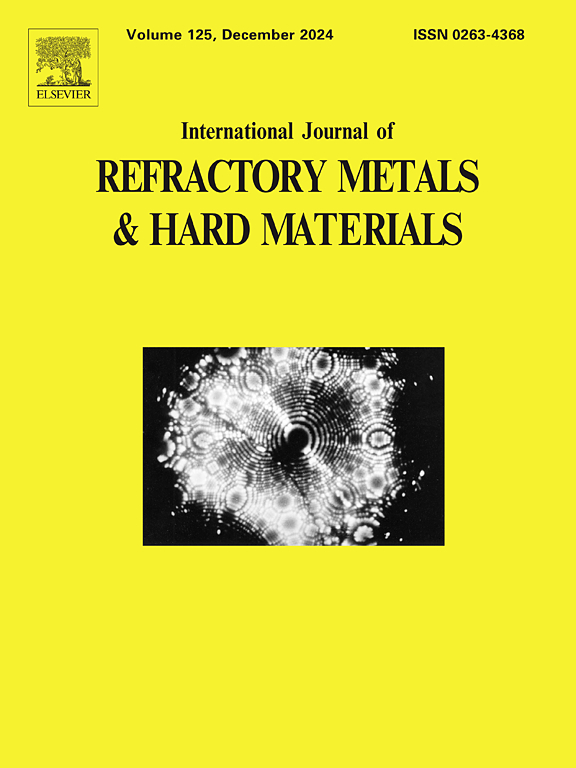硬质合金微铣削韧性模态控制的实验研究
IF 4.2
2区 材料科学
Q2 MATERIALS SCIENCE, MULTIDISCIPLINARY
International Journal of Refractory Metals & Hard Materials
Pub Date : 2025-02-24
DOI:10.1016/j.ijrmhm.2025.107119
引用次数: 0
摘要
硬质材料的微铣削加工是一种有效的加工技术,可以获得难以加工的金属基复合材料(如硬质合金)的高精度零件。尽管它们具有脆性的机械行为,但在特定的操作条件下,塑性流(韧性)切割会发生,从而在超精密机器和部件上实现重大的技术进步。这种脆性-延性阈值(根据磨削操作定义)取决于材料特性,例如工具-工件材料对的弹性模量、材料硬度和断裂韧性。尽管加工规模相似,但磨削和微铣削在切削刃的定义上存在显著差异,而微铣削操作对稳定延性切削的控制仍然相当未被探索。在目前的工作中,微铣削WC-15wt。用金刚石涂层立铣刀进行了%Co烧结样品的加工,证实了韧性-脆性阈值对切削状态的影响。验证了临界尺度效应和结构相关行为,以及激光锐化涂层边缘半径优化的影响。采用韧性切割模式对加工表面质量有积极影响,采用激光锐化技术控制边缘半径也有积极影响。利用扫描电子显微镜和微观三维形貌对不同加工条件下的加工表面微观结构特征进行了评价。实验研究证实了硬质合金微铣削过程中可以控制切削状态,刃口半径对犁削效果有很大影响,并且可以采用激光刃口处理作为控制这种尺度效应的解决方案。尖锐的边缘导致了加工表面质量的降低。本文章由计算机程序翻译,如有差异,请以英文原文为准。
An experimental study for ductile mode control on cemented carbide micro-milling
Micro-milling of hard materials can be an efficient processing technique to attain high-precision parts in difficult-to-machine metal matrix composites, such as cemented carbide. Despite their brittle mechanical behavior, within specific operational conditions plastic-flow (ductile) cutting occurs, enabling significant technological advances on ultra-precision machines and components. This brittle-to-ductile threshold (which has been defined based on grinding operations) depends on material properties, such as the elastic modulus, material hardness and fracture toughness of the tool-workpiece materials pair. Despite the similar process size scale, grinding and micro-milling significantly differ on how well defined the cutting edges are, and the control of micro-milling operations towards stable ductile cutting is still rather unexplored. In the present work, micro-milling of WC-15wt.%Co sintered samples was performed with diamond coated end mills, confirming the influence of a ductile-to-brittle threshold on the cutting regime. Critical scale effects and structure-related behavior were also confirmed, as well as the impact of edge radius optimization with laser sharpened coating. A positive effect on machined surface quality was observed when ductile cutting regime mode was applied, likewise the effect of edge radius control with laser sharpness technology. Scanning electron microscopy and micro 3D topography were used to evaluate the machined surface microstructure features after different machining conditions, The experimental study confirmed the ability to control the cutting regime during micro milling of cemented carbide, the great impact of the edge radius on the ploughing effect and the ability to apply laser edge treatment as a solution to control this scale effect, however, the sharp edges promoted a reduction in the quality of the machined surfaces.
求助全文
通过发布文献求助,成功后即可免费获取论文全文。
去求助
来源期刊
CiteScore
7.00
自引率
13.90%
发文量
236
审稿时长
35 days
期刊介绍:
The International Journal of Refractory Metals and Hard Materials (IJRMHM) publishes original research articles concerned with all aspects of refractory metals and hard materials. Refractory metals are defined as metals with melting points higher than 1800 °C. These are tungsten, molybdenum, chromium, tantalum, niobium, hafnium, and rhenium, as well as many compounds and alloys based thereupon. Hard materials that are included in the scope of this journal are defined as materials with hardness values higher than 1000 kg/mm2, primarily intended for applications as manufacturing tools or wear resistant components in mechanical systems. Thus they encompass carbides, nitrides and borides of metals, and related compounds. A special focus of this journal is put on the family of hardmetals, which is also known as cemented tungsten carbide, and cermets which are based on titanium carbide and carbonitrides with or without a metal binder. Ceramics and superhard materials including diamond and cubic boron nitride may also be accepted provided the subject material is presented as hard materials as defined above.

 求助内容:
求助内容: 应助结果提醒方式:
应助结果提醒方式:


